Evaluation of the Change in Undrained Shear Strength in Cohesive Soils due to Principal Stress Rotation Using an Artificial Neural Network
Abstract
1. Introduction
2. Materials and Methods
3. Results
4. Artificial Neural Network Analysis
4.1. Architecture of the Artificial Neural Network
- −
- Relative error (for individual cases):
- −
- Determination coefficient, R2:
- −
- Mean absolute error:
- −
- Root mean squared error:where di is the measured value, yi is the value predicted by the neural network, di is the measured mean value in a given subset, and denotes the case number from subsets , , or with cardinality P, where i ∈ {1, ..., P}.
4.2. Datasets
4.3. Training and Testing
4.4. Neural Network Prediction
5. Conclusions
Author Contributions
Acknowledgments
Conflicts of Interest
References
- Jardine, R.J. One perspective of the pre-failure deformation characteristics of some geomaterials. Pre-failure Deformation of Geomaterials. Proc. Sapporo. Balkema Rotterdam. 1995, 2, 855–885. [Google Scholar]
- Lipiński, M.J.; Wdowska, M.K. A stress history and strain dependent stiffness of overconsolidated cohesive soil. Ann. Warsaw Univ. Life Sci.—SGGW Land Reclam. 2011, 43, 207–216. [Google Scholar] [CrossRef]
- Hight, D.W.; Gens, A.; Symes, M.J. The development of a new hollow cylinder apparatus for investigating the effects of principal stress rotation in soils. Géotechnique 1983, 33, 335–383. [Google Scholar] [CrossRef]
- Lade, V.P.; Kirkgard, M.M. Effects of stress rotation and changes of b-values on cross-anisotropic behavior of natural Ko consolidated soft clay. Soils Found. 2000, 40, 93–105. [Google Scholar] [CrossRef]
- Lin, H.; Penumadu, D. Experimental investigation on principal stress rotation in Kaolin Clay. J. Geotech. Geoenviron. Eng. 2005, 131, 633–642. [Google Scholar] [CrossRef]
- Nishimura, S.; Minh, N.A.; Jardine, R.J. Shear strength anisotropy of natural London Clay. Géotechnique 2007, 57, 49–62. [Google Scholar] [CrossRef]
- Rolo, R. The Anisotropic Stress-Strain-Strength Behavior of Brittle Sediments. Ph.D. Thesis, Imperial College, London, UK, 2003. [Google Scholar]
- Zdravković, L.; Jardine, R.J. The effects on anisotropy of rotating the principal stress axes during consolidation. Géotechnique 2001, 51, 69–83. [Google Scholar] [CrossRef]
- Bishop, A.W. The strength of soils as engineering materials. Géotechnique 1966, 16, 91–130. [Google Scholar] [CrossRef]
- Kulhavy, F.H.; Mayne, P.W. Manual on Estimating Soil Properties for Foundation Design; Report EK-6800; Electric Power Research Institute: Palo Alto, CA, USA, 1990. [Google Scholar]
- Ching, J.; Phoon, K.K. Multivariate distribution for undrained shear strength under various test procedures. Can. Geotech. J. 2013, 50, 907–923. [Google Scholar] [CrossRef]
- Houlsby, N.M.T.; Houlsby, G.T. Statistical fitting of undrained strength data. Géotechnique 2013, 63, 1253–1263. [Google Scholar] [CrossRef]
- Jang, D.; Park, H.; Choi, G. Estimation of Leakage Ratio Using Principal Component Analysis and Artificial Neural Network in Water Distribution Systems. Sustainability 2018, 10, 750. [Google Scholar] [CrossRef]
- Kang, P.-S.; Lim, J.-S.; Huh, C. Artificial Neural Network Model to Estimate the Viscosity of Polymer Solutions for Enhanced Oil Recovery. Appl. Sci. 2016, 6, 188. [Google Scholar] [CrossRef]
- Li, W.; Cui, L.; Zhang, Y.; Cai, Z.; Zhang, M.; Xu, W.; Zhao, X.; Lei, Y.; Pan, X.; Li, J.; et al. Using a Backpropagation Artificial Neural Network to Predict Nutrient Removal in Tidal Flow Constructed Wetlands. Water 2018, 10, 83. [Google Scholar] [CrossRef]
- Zhu, X.; Fan, Y.; Zhang, F.; Ye, X.; Chen, C.; Yue, H. Multiple-Factor Based Sparse Urban Travel Time Prediction. Appl. Sci. 2018, 8, 279. [Google Scholar] [CrossRef]
- Paez, T.L. Neural networks in mechanical systems simulation, identification and assessment. Shock Vibr. 1993, 1, 177–199. [Google Scholar] [CrossRef][Green Version]
- Adeli, H. Neural Networks in Civil Engineering: 1989–2000. Comput.-Aided Civ. Inf. 2001, 16, 126–142. [Google Scholar] [CrossRef]
- Ghaboussi, J. Biologically inspired soft computing methods in structural mechanics and engineering. Struct. Eng. Mech. 2001, 11, 485–502. [Google Scholar] [CrossRef]
- Rojas, R. Neural Networks: A Systematic Introduction; Springer: Berlin, Germany, 1996. [Google Scholar]
- Waszczyszyn, Z. Advances of Soft Computing in Engineering; CISM Courses and Lectures; Springer: Wien, Austria; New York, NY, USA, 2010. [Google Scholar]
- Waszczyszyn, Z. Artificial neural networks in civil engineering: another five years of research in Poland. Comp. Assist. Mech. Eng. Sci. 2011, 18, 131–146. [Google Scholar]
- Rafiq, M.Y.; Bugmann, G.; Easterbrook, D.J. Neural network design for engineering applications. Comput. Struct. 2001, 79, 1541–1552. [Google Scholar] [CrossRef]
- Dihoru, L.; Muir Wood, D.; Sadek, T.; Lings, M. A neural network for error prediction in true triaxial apparatus with flexible boundaries. Comput. Geotech. 2005, 32, 59–71. [Google Scholar] [CrossRef]
- Pichler, B.; Lackner, R.; Mang, H.A. Back analysis of model parameters in geotechnical engineering by means of soft computing. Int. J. Numer. Meth. Eng. 2003, 57, 1943–1978. [Google Scholar] [CrossRef]
- Shahin, M.A.; Jaksa, M.B.; Maier, H.R. Artificial Neural Network applications in geotechnical engineering. Aust. Geomechan. 2001, 36, 49–62. [Google Scholar]
- Shahin, M.A.; Jaksa, M.B.; Maier, H.R. State of the art of Artificial Neural Networks in geotechnical engineering. Elect. J. Geotech. Eng. 2008, 8, 1–26. [Google Scholar]
- Tian, J.; Li, C.; Liu, J.; Yu, F.; Cheng, S.; Zhao, N.; Wan Jaafar, W.Z. Groundwater Depth Prediction Using Data-Driven Models with the Assistance of Gamma Test. Sustainability 2016, 8, 1076. [Google Scholar] [CrossRef]
- Sulewska, M.J. Applying artificial neural networks for analysis of geotechnical problems. Comp. Assist. Mech. Eng. Sci. 2011, 18, 231–241. [Google Scholar]
- Zhou, T.; Wang, F.; Yang, Z. Comparative Analysis of ANN and SVM Models Combined with Wavelet Preprocess for Groundwater Depth Prediction. Water 2017, 9, 781. [Google Scholar] [CrossRef]
- Basheer, I.A. Selection of methodology for neural network modeling of constitutive hysteresis behavior of soils. Comput.-Aided Civ. Inf. 2000, 15, 440–458. [Google Scholar] [CrossRef]
- Ellis, G.W.; Yao, C.; Zhao, R.; Penumadu, D. Stress-strain modeling of sands using artificial neural network. J. Geotech. Eng. 1995, 121, 429–435. [Google Scholar] [CrossRef]
- Fu, Q.; Hashash, Y.M.A.; Hung, S.; Ghaboussi, J. Integration of laboratory testing and constitutive modeling of soils. Comput. Geotech. 2007, 34, 330–345. [Google Scholar] [CrossRef]
- Najjar, Y.M.; Huang, C. Simulating the stress-strain behavior of Georgia kaolin via recurrent neuronet approach. Comput. Geotech. 2007, 34, 346–361. [Google Scholar] [CrossRef]
- Penumadu, D.; Zhao, R. Triaxial compression behavior of sand and gravel using artificial neural networks (ANN). Comput. Geotech. 1999, 24, 207–230. [Google Scholar] [CrossRef]
- Sidarta, D.E.; Ghaboussi, J. Constitutive modeling of geomaterials from non-uniform material test. Comput. Geotech. 1998, 22, 53–71. [Google Scholar] [CrossRef]
- Lee, S.J.; Lee, S.R.; Kim, Y.S. An approach to estimate unsaturated shear strength using artificial neural network and hyperbolic formulation. Comput. Geotech. 2003, 30, 489–503. [Google Scholar] [CrossRef]
- Das, S.K.; Basudhar, P.K. Undrained lateral load capacity of piles in clay using artificial neural network. Comput. Geotech. 2006, 33, 454–459. [Google Scholar] [CrossRef]
- Byeon, W.Y.; Lee, S.R.; Kim, Y.S. Application of flat DMT and ANN to Korean soft clay deposits for reliable estimation of undrained shear strength. Int. J. Offshore Pol. Eng. 2006, 16, 73–80. [Google Scholar]
- Kiziewicz, D. Evaluation of Shear Strength of Cohesive Soils with Use of Non-Standard Stress Path. Ph.D. Thesis, Warsaw University of Life Sciences, Warsaw, Poland, 2012. [Google Scholar]
- Wrzesiński, G. Stability Analysis of an Embankment with Influence of Principal Stress Rotation on the Shear Strength of Subsoil. Ph.D. Thesis, Warsaw University of Life Sciences, Warsaw, Poland, 2016. [Google Scholar]
- EN ISO 14688-1. Geotechnical Investigation and Testing—Identification and Classification of Soil—Part 1: Identification and Description; International Organization for Standardization: Geneva, Switzerland, 2002. [Google Scholar]
- EN ISO 14688-2. Geotechnical Investigation and Testing—Identification and Classification of Soil—Part 2: Principles for a Classification; International Organization for Standardization: Geneva, Switzerland, 2004. [Google Scholar]
- Wrzesiński, G.; Lechowicz, Z. Influence of the rotation of principal stress directions on undrained shear strength. Ann. Warsaw Univ. Life Sci.—SGGW Land Reclam. 2013, 45, 183–192. [Google Scholar] [CrossRef][Green Version]
- Wrzesiński, G.; Lechowicz, Z. Testing of undrained shear strength in a Hollow Cylinder Apparatus. Studia Geotechnica et Mechanica 2015, 37, 69–73. [Google Scholar] [CrossRef]
- Masters, T. Practical Neural Network Recipes in C++; Academic Press: New York, NY, USA, 1993. [Google Scholar]
- Bishop, C.M. Neural Networks for Pattern Recognition; Oxford University Press: Oxford, UK, 1995. [Google Scholar]
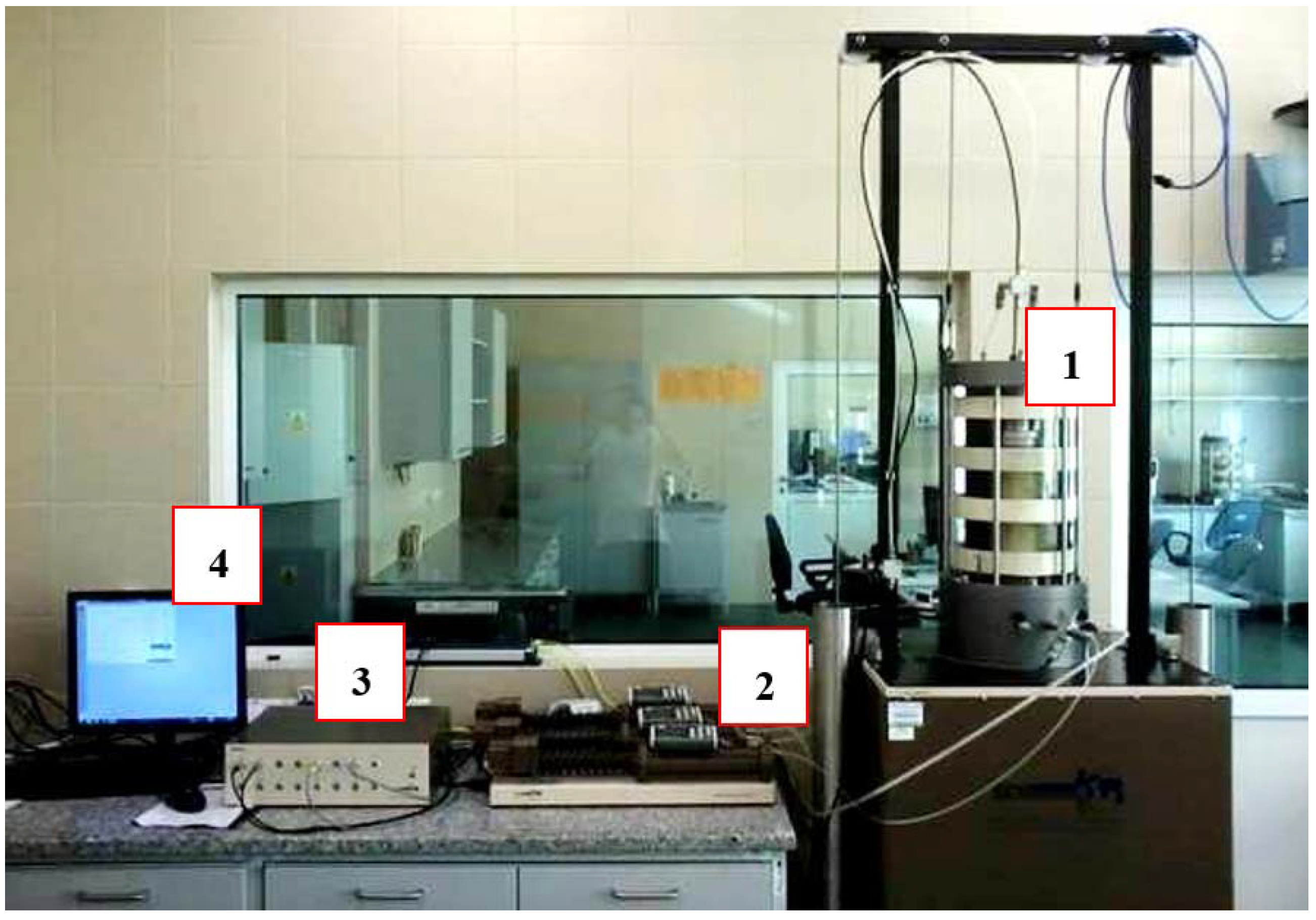
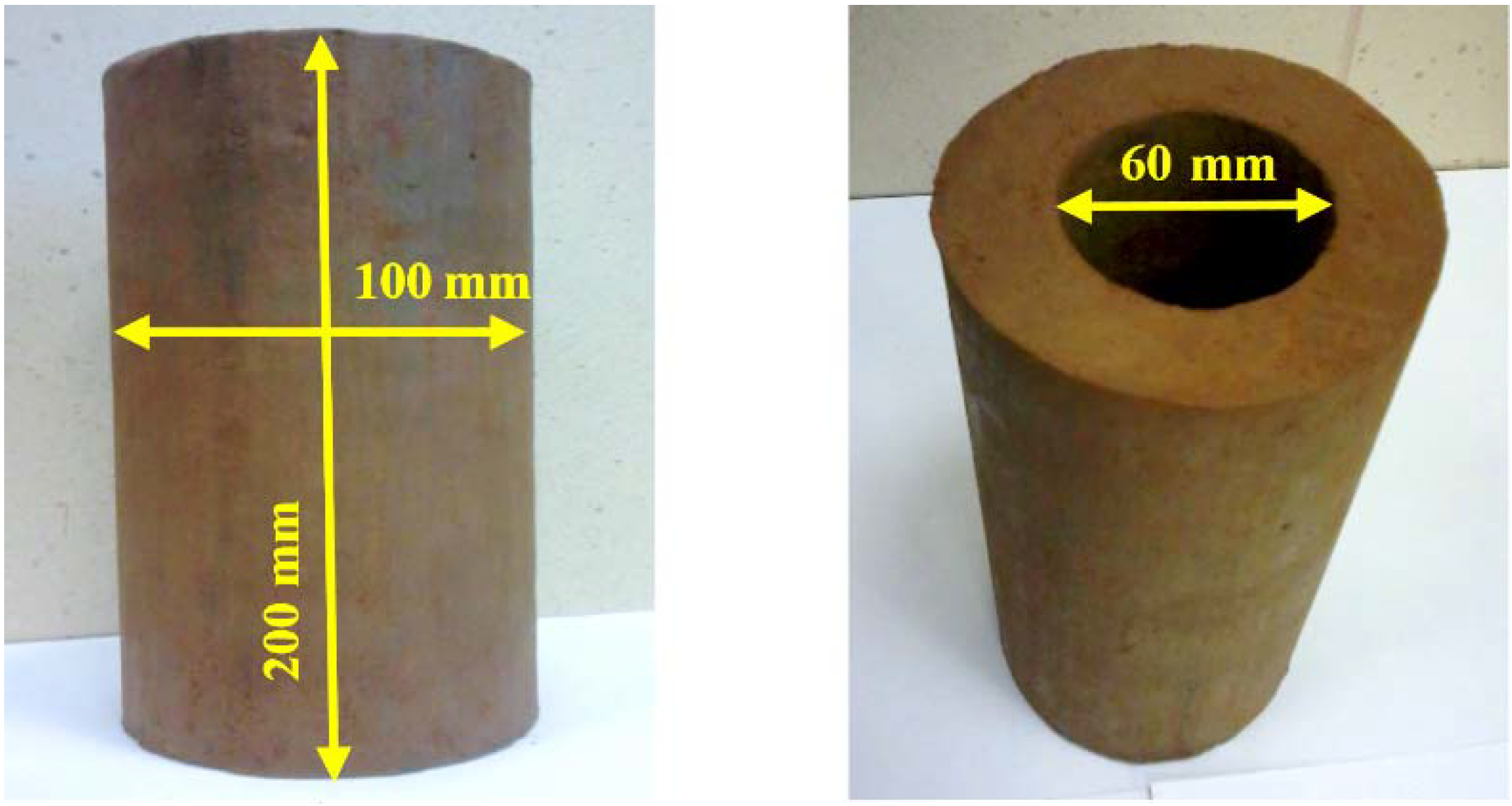
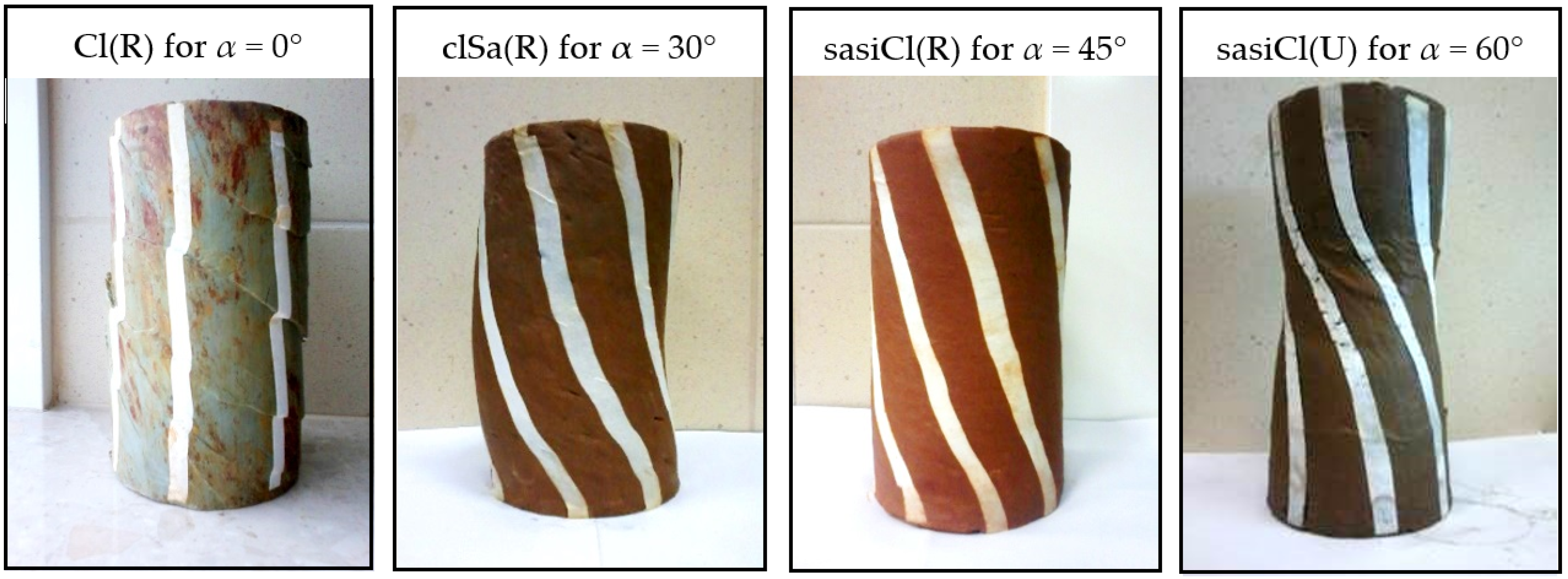
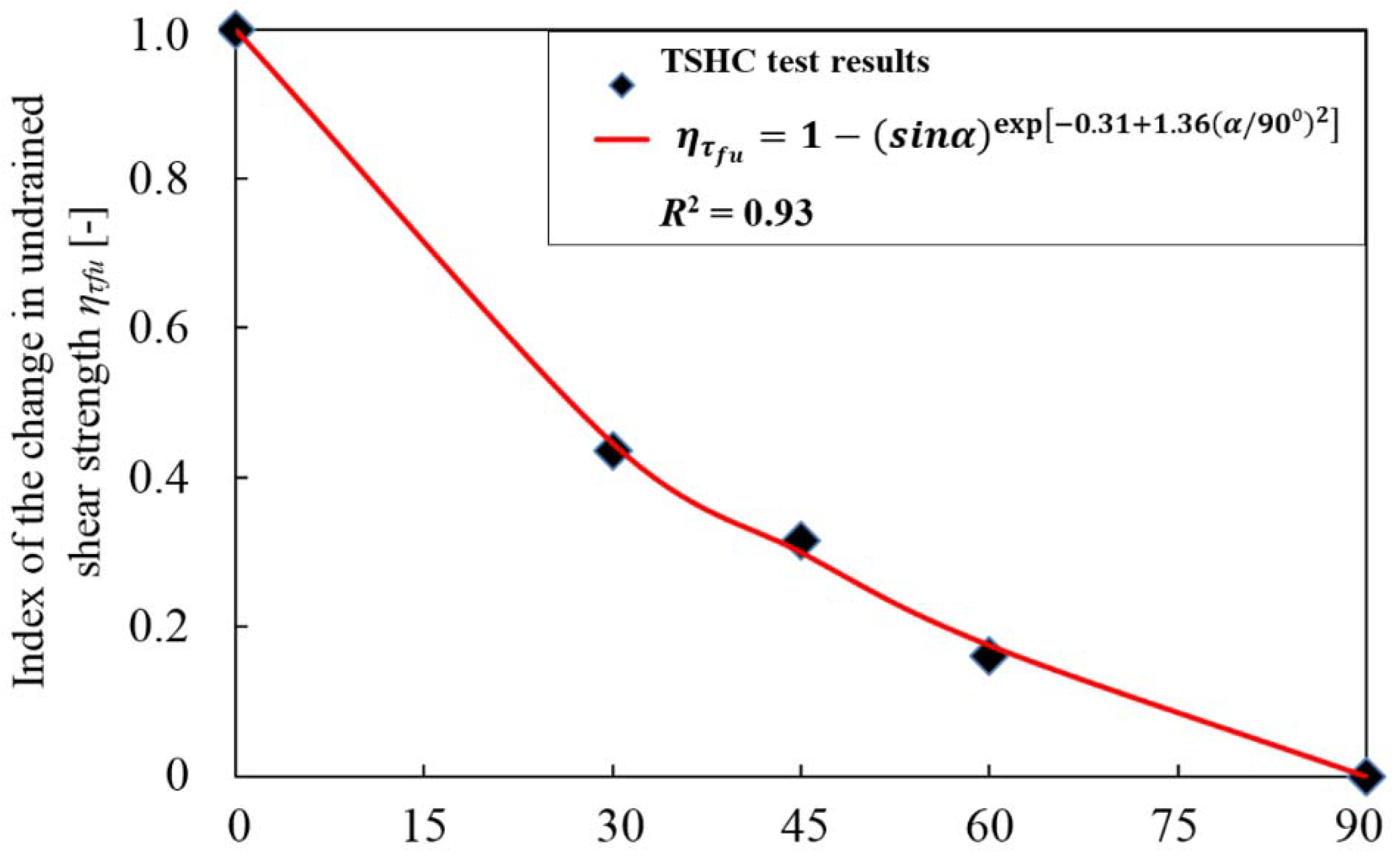
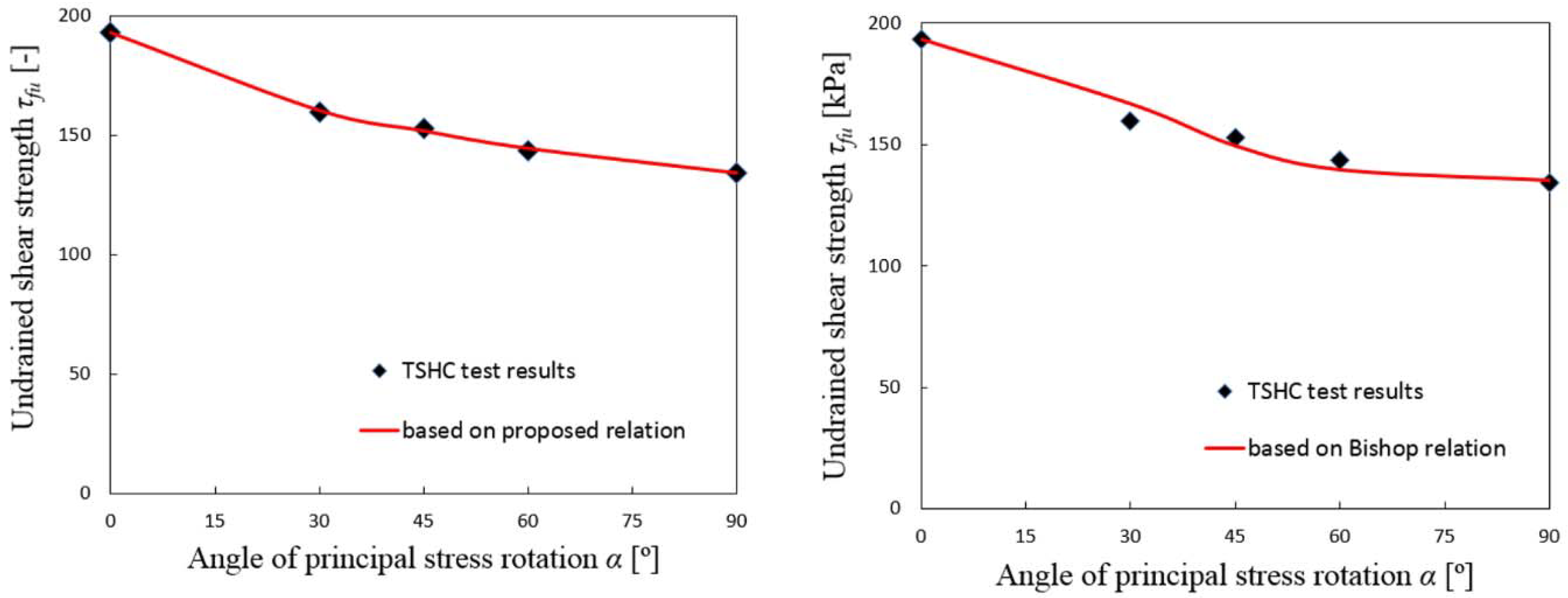
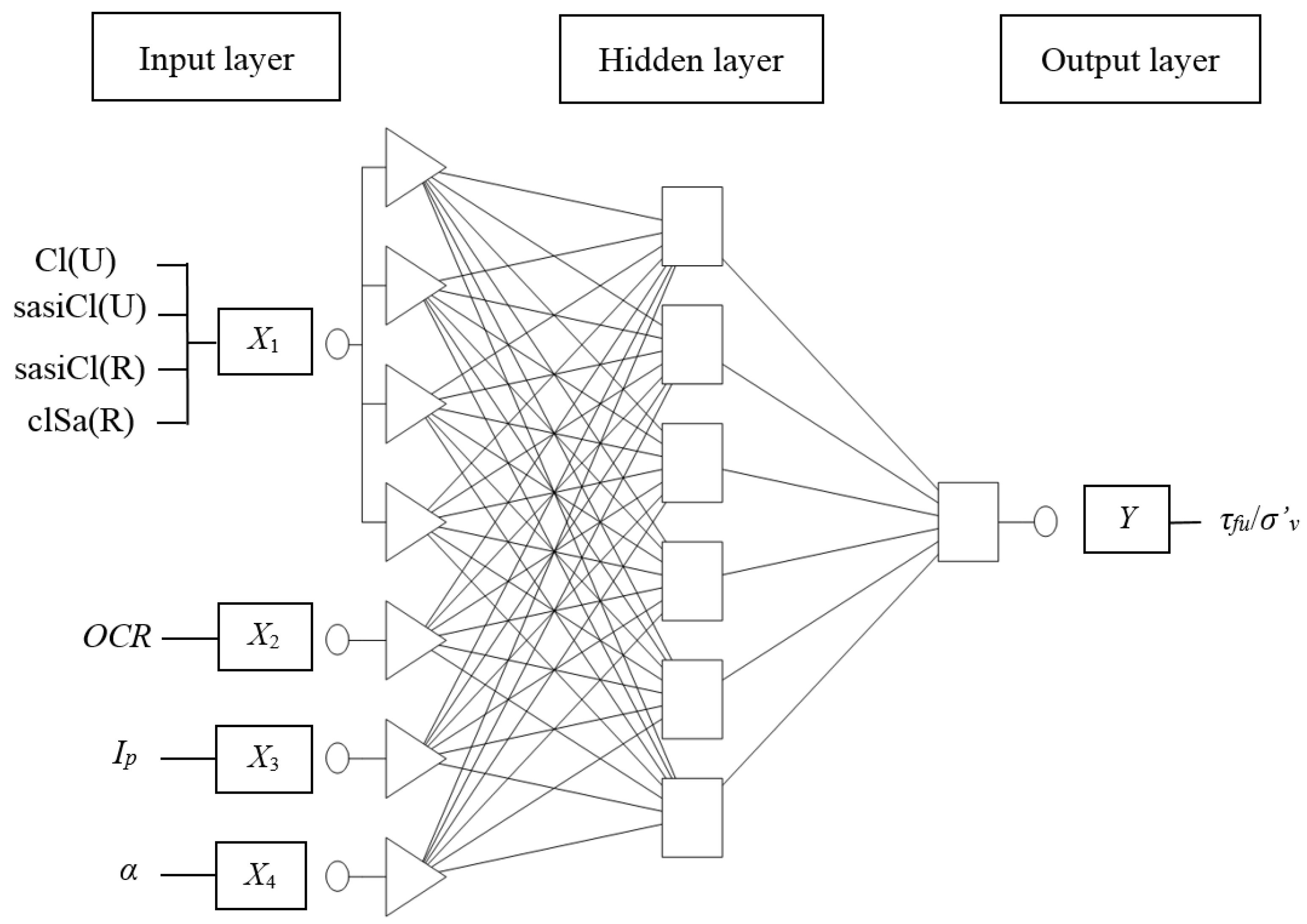
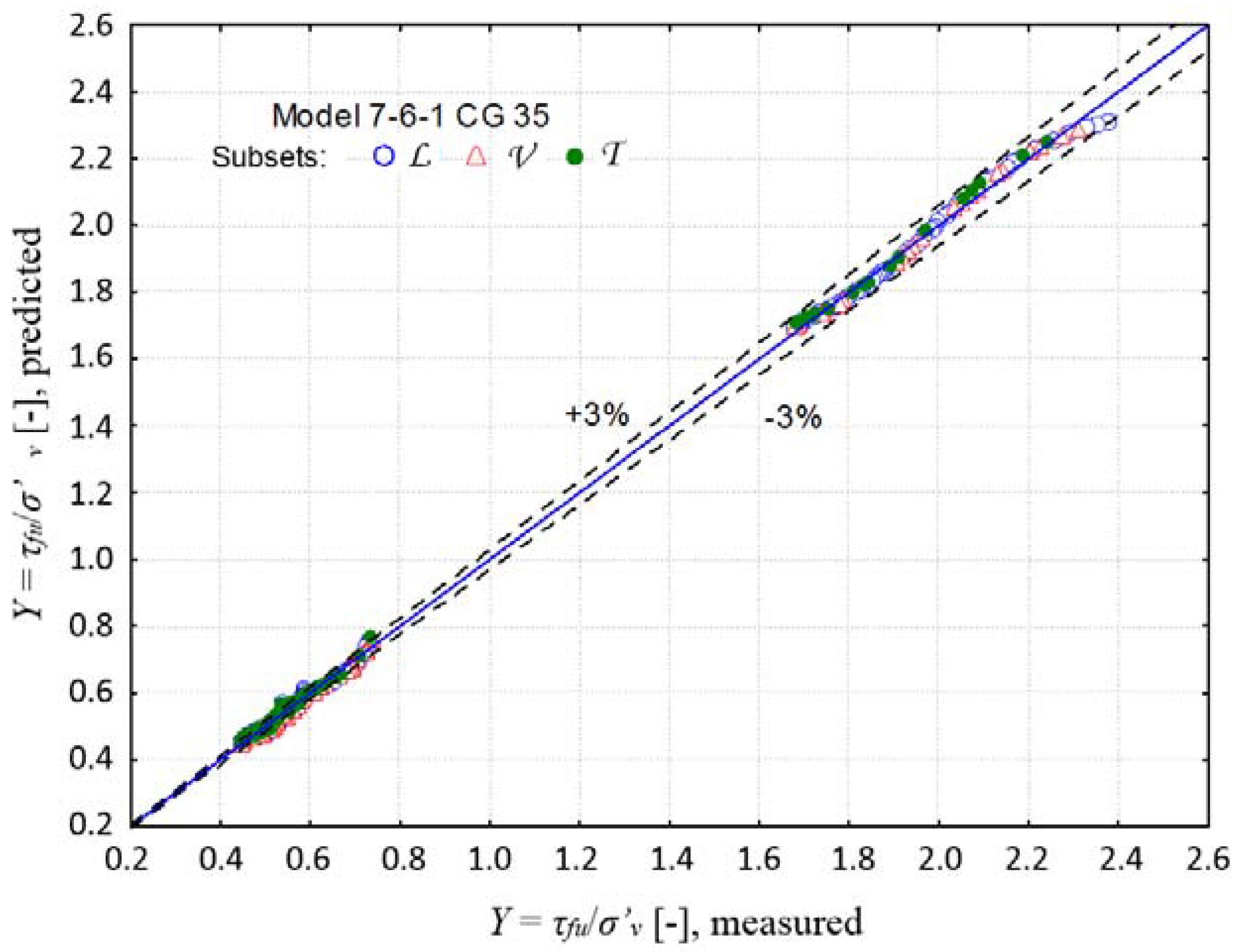
| Soil type [42] | wL (%) | wP (%) | IL (-) | IC (-) | Fraction [43] (%) | |||
|---|---|---|---|---|---|---|---|---|
| Gr | Sa | Si | Cl | |||||
| Cl(U) | 112.9 | 35.3 | −0.06 | 1.06 | 0 | 5 | 36 | 59 |
| sasiCl(U) sasiCl(R) | 59.0 | 24.3 | 0.13 | 0.87 | 0 | 21 | 50 | 29 |
| clSa(R) | 19.4 | 8.7 | 0.75 | 0.25 | 0 | 70 | 19 | 11 |
| Soil Type (X1) | Over-Consolidation Ratio OCR (-) (X2) | Plasticity Index IP (%) (X3) | Angle of the Principal Stress Rotation α (°) (X4) | Undrained Shear Strength τfu (kPa) | Effective Vertical Stress σ’v (kPa) | Normalized Undrained Shear Strength τfu/σ’vo (-) (Y) | Coefficients of Equation (5) | ||
|---|---|---|---|---|---|---|---|---|---|
| ao | a1 | n | |||||||
| Cl(U) | 3.5 | 77.6 | 0 | 228.5 | 310 | 0.737 | 0.34 | −0.80 | 2 |
| 30 | 201.8 | 0.651 | |||||||
| 45 | 178.5 | 0.576 | |||||||
| 60 | 172.4 | 0.556 | |||||||
| 90 | 160.1 | 0.516 | |||||||
| sasiCl(U) | 2.7 | 34.7 | 0 | 129.3 | 220 | 0.588 | 0.52 | −2.14 | 2 |
| 15 | 125.8 | 0.572 | |||||||
| 30 | 117.7 | 0.535 | |||||||
| 45 | 106.6 | 0.485 | |||||||
| 60 | 101.4 | 0.461 | |||||||
| 75 | 99.8 | 0.454 | |||||||
| 90 | 98.4 | 0.447 | |||||||
| sasiCl(R) | 2.7 | 34.7 | 0 | 118.7 | 220 | 0.54 | 0.64 | −0.20 | 2 |
| 15 | 117.5 | 0.534 | |||||||
| 30 | 115.2 | 0.524 | |||||||
| 45 | 110.6 | 0.503 | |||||||
| 60 | 107.4 | 0.488 | |||||||
| 75 | 105.5 | 0.48 | |||||||
| 90 | 104.2 | 0.478 | |||||||
| clSa(R) | 8 | 10.5 | 0 | 193.2 | 80 | 2.415 | −0.31 | 1.36 | 2 |
| 30 | 159.9 | 1.999 | |||||||
| 45 | 152.7 | 1.909 | |||||||
| 60 | 143.6 | 1.795 | |||||||
| 90 | 134.1 | 1.676 | |||||||
| Measures of Errors | Subset learning, | Subset testing, | Subset validation, |
|---|---|---|---|
| RMS | 0.0057 | 0.0054 | 0.0052 |
| MAE | 0.0109 | 0.0110 | 0.0105 |
| R2 | 0.998 | 0.998 | 0.998 |
| No. | Measured Values τfu/σ’v from Set di (-) | Predicted Values τfu/σ’v Based on 7–6–1 Network yi (-) | Relative Errors of Individual Case REi (%) |
|---|---|---|---|
| 1 | 0.737 | 0.775 | 5.16 |
| 2 | 0.651 | 0.634 | 2.61 |
| 3 | 0.576 | 0.59 | 2.43 |
| 4 | 0.556 | 0.554 | 0.36 |
| 5 | 0.516 | 0.512 | 0.77 |
| 6 | 0.588 | 0.612 | 4.08 |
| 7 | 0.572 | 0.558 | 2.45 |
| 8 | 0.535 | 0.52 | 2.8 |
| 9 | 0.485 | 0.491 | 1.24 |
| 10 | 0.461 | 0.468 | 1.52 |
| 11 | 0.454 | 0.455 | 0.22 |
| 12 | 0.447 | 0.452 | 1.12 |
| 13 | 0.54 | 0.572 | 5.92 |
| 14 | 0.534 | 0.531 | 0.56 |
| 15 | 0.524 | 0.5 | 4.58 |
| 16 | 0.503 | 0.48 | 4.57 |
| 17 | 0.488 | 0.47 | 3.69 |
| 18 | 0.48 | 0.47 | 2.08 |
| 19 | 0.478 | 0.478 | 0 |
| 20 | 2.415 | 2.322 | 3.85 |
| 21 | 1.999 | 2.019 | 1 |
| 22 | 1.909 | 1.885 | 1.26 |
| 23 | 1.795 | 1.789 | 0.33 |
| 24 | 1.676 | 1.694 | 1.07 |
| Max RE13 = 5.92% |
© 2018 by the authors. Licensee MDPI, Basel, Switzerland. This article is an open access article distributed under the terms and conditions of the Creative Commons Attribution (CC BY) license (http://creativecommons.org/licenses/by/4.0/).
Share and Cite
Wrzesiński, G.; Sulewska, M.J.; Lechowicz, Z. Evaluation of the Change in Undrained Shear Strength in Cohesive Soils due to Principal Stress Rotation Using an Artificial Neural Network. Appl. Sci. 2018, 8, 781. https://doi.org/10.3390/app8050781
Wrzesiński G, Sulewska MJ, Lechowicz Z. Evaluation of the Change in Undrained Shear Strength in Cohesive Soils due to Principal Stress Rotation Using an Artificial Neural Network. Applied Sciences. 2018; 8(5):781. https://doi.org/10.3390/app8050781
Chicago/Turabian StyleWrzesiński, Grzegorz, Maria Jolanta Sulewska, and Zbigniew Lechowicz. 2018. "Evaluation of the Change in Undrained Shear Strength in Cohesive Soils due to Principal Stress Rotation Using an Artificial Neural Network" Applied Sciences 8, no. 5: 781. https://doi.org/10.3390/app8050781
APA StyleWrzesiński, G., Sulewska, M. J., & Lechowicz, Z. (2018). Evaluation of the Change in Undrained Shear Strength in Cohesive Soils due to Principal Stress Rotation Using an Artificial Neural Network. Applied Sciences, 8(5), 781. https://doi.org/10.3390/app8050781






